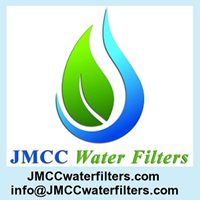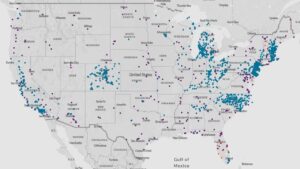Chapter 2 – PFAS “Forever Chemicals” are everywhere.
When water goes to the municipal “treatment plant” or your own private septic system, there is a misconception that the water is “purified” and then returns to rivers and the water table. The reality is that they only break down the human waste and ALL of the chemicals, pollutants, YES and pharmaceuticals etc. are not treated at all. These chemicals typically have long life times. They accumulate in the water supply, surface water or deep wells after leaving the “treatment plant”.
We will start with the one of the worst and most pervasive chemicals to ever meet the water table. It is a family of chemicals called PFAS chemicals. The most common household example is Teflon.
| What are PFAS?
Perfluoroalkyl substances (PFAS) are very stable manmade chemicals that have properties that allow them to repel both water and oil. The different PFAS have different lengths and/or differ in their properties at one end, which can change the toxicity of the chemicals. The most commonly found and best studied PFAS are perfluorooctanoic acid (PFOA) and perfluorooctanesulfonic acid (PFOS). |
| Where are they found?
The fat and water repelling properties of these substances allowed them to be applied to almost any material to make it water, oil, and stain repellant. These properties were first used commercially in the1950s, and they are used in a wide variety of consumer products, including carpets, clothing, non-stick pans, paints, polishes, waxes, cleaning products, and food packaging. Firefighters and the military use them in fire-suppressing foam. PFAS do not readily breakdown in the environment and are water soluble. As a result, there are very low levels of PFAS in many areas of the environment. Higher levels can be found in water supplies near facilities that manufactured, disposed, or used PFAS. |
| How can I be exposed to PFAS?
Exposure to PFAS could occur through: public water systems and drinking water wells, soil, and outdoor air near industrial areas with frequent PFAS manufacture, disposal, or use indoor air or dust in spaces that contain carpets, textiles, and other consumer products treated with PFAS to resist stains surface water (lakes, ponds, etc.) or groundwater receiving run-off or seepage from areas where firefighting foam was often used (like military or civilian airfields) fish from contaminated bodies of water food items sold in marketplace food packages |
| As you can see, PFAS chemicals have to be removed from your water supply. Mothers and children are particularly susceptible to the health problems associated with PFAS.
How do unborn babies and young children get exposed to PFAS? Unborn babies can be exposed to PFAS through umbilical cord blood from their mothers during pregnancy. Newborns can be exposed to PFAS through breast milk or through formula made with water that contains PFAS. Older children may be exposed to PFAS through food, water, and other products, similar to adults. Young children have a higher risk of exposure to PFAS from carpet and cleaning products, largely due to time spent lying and crawling on floors in their early years. To purchase the MR5 system and accessories click here –> MR5 Purchase here |
| EPA has issued guidance to state and local governments and public water providers about levels of PFOA and PFOS in drinking water and groundwater that are potentially concerning. Many states are passing laws that require water providers to keep the concentration of these compounds below that level. The only problem is that implementing these guidelines on a municipal level may take years and require local expenditures which may change the guidelines. |
| What steps should I take? We know that concerning levels of PFAS have been detected in the majority of house water supplies in the USA.
To minimize risk: DO NOT boil your water. Boiling water will concentrate these chemicals. Reduce your risk of exposure to these chemicals by using a Whole House water filter designed to reduce these chemicals to minimal levels. Bottled water many times can be worse than tap water. If you must use a humidifier, only use water from a safe filtered source. Parents of formula-fed infants should use filtered water only. The greatest risk is when taking a shower without a whole house water filter. The small shower screw on filters you purchase at the big box store are not designed to remove PFAS or other chemicals and have very short life times. The JMCC Water Filters MR5 filter is designed to reduce PFAS and other chemicals to safe levels. |
| Here are some of the scientifically studied effects of PFAS in animals and humans
· cause developmental effects in infants · lower a woman’s chance of getting pregnant · increase a woman’s blood pressure during pregnancy · lower infant birth weights · interfere with the body’s natural hormones · increase cholesterol levels · affect the immune system · increase the risk of cancer |
| Is it safe to breastfeed my baby?
Breastfeeding is associated with numerous health benefits for infants and mothers. The science on the health effects of PFAS for mothers and babies is evolving. However, given the scientific understanding at this time, the benefits of breastfeeding your baby outweighs those of not breastfeeding. Do not gamble with your baby’s health either pre-natal or post-natal. Removing PFAS chemicals from your water to protect you and your family is important. From the time the mother becomes pregnant to delivery, the baby is taking all nutrients from the mother and therefore mothers especially should be drinking and showering in water free from chemicals. You receive more chemicals during a shower than any other source of pollution. |
| Besides being in food raised from ground water and municipal water supplies, there is an understanding that almost all ground water in the USA has been contaminated. The following map shows the locations where high concentrations of PFAS chemicals have been confirmed. These include all major metropolitan city water supplies. There is an increasing realization that these chemicals have been in the water tables for decades and have moved into rural areas surrounding these metropolitan areas. Long term health affects are known and you have to remove these chemicals from your water before you drink, cook, wash vegetables and fruits, water a garden AND MOST OF ALL TAKING A HOT SHOWER. Showering accumulates more chemical intake in the body than any other source as it is absorbed through the skin and by breathing in the warm water vapor. That is why you need a whole house water filter to remove these for all water use in your house. Is your location on the PFAS map below? If so, you need a JMCC Water Filters MR5 Whole House Water Filter designed to remove these chemicals. A simple water softener will not remove PFAS chemicals. To purchase the MR5 system and accessories click here –> MR5 Purchase here
Click here to purchase MR5 Whole House Water Filter –> whole-house-water-filter |

